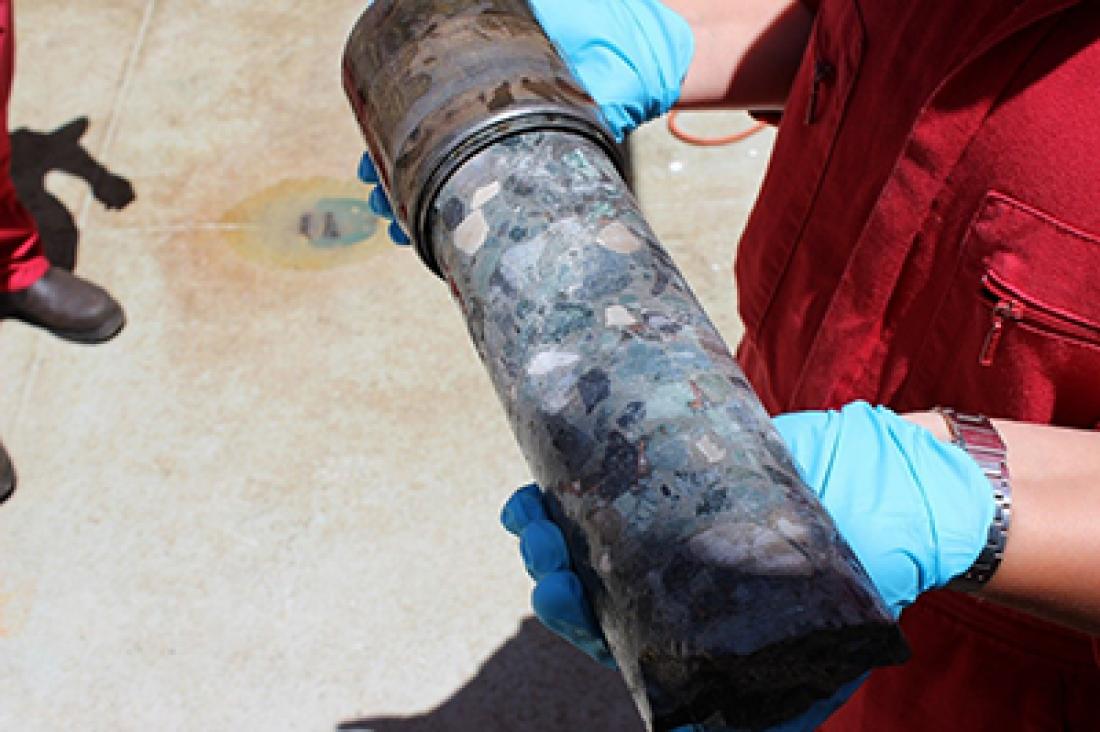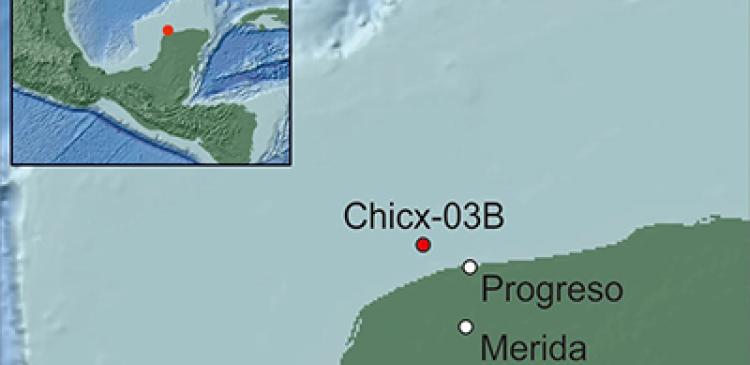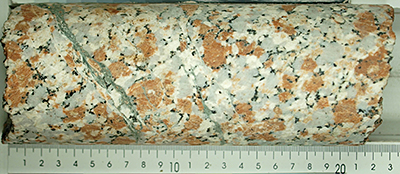Sedimentary rock (breccia) from collision impact.
Credit: J.Morgan
Around 65 million years ago, a massive asteroid crashed into the Gulf of Mexico causing an impact so huge that the blast and subsequent knock-on effects wiped out around 75 percent of all life on Earth, including most of the dinosaurs. This is known as the Chicxulub impact.
Understanding the formation process of the Chicxulub crater is critically important to estimating the released energy from the impact and the causative environmental changes that triggered mass extinction. But because the crater is filled with a few hundred metres worth of thick, post-impact carbonates, drilling is necessary to obtain impact-related sediments.
An international team of scientists - including four Japanese members- planned to take samples through the International Ocean Discovery Program (IODP).
In April and May 2016, the team undertook an offshore expedition and drilled into part of the Chicxulub impact crater. Their mission was to retrieve samples from the rocky inner ridges of the crater - known as the 'peak ring' - drilling 506 to 1335 metres below the modern day sea floor to understand more about the ancient cataclysmic event.
Now, the researchers have carried out the first analysis of the core samples. They found that the impact millions of years ago deformed the peak ring rocks in such a way that it made them more porous and less dense, than any models had previously predicted.
Porous rocks provide niches for simple organisms to take hold, and there would also be nutrients available in the pores, from circulating water that would have been heated inside the Earth's crust. Early Earth was constantly bombarded by asteroids, and the team has inferred that this bombardment must have also created other rocks with similar physical properties. This may partly explain how life took hold on Earth.
The study, which is published today in the journal Science, also confirmed a model for how peak rings were formed in the Chicxulub crater, and how peak rings may be formed in craters on other planetary bodies.
The team's new work has confirmed that the asteroid, which created the Chicxulub crater, hit the Earth's surface with such a force that it pushed rocks, which at that time were ten kilometres beneath the surface, farther downwards and then outwards. These rocks then moved inwards again towards the impact zone and then up to the surface, before collapsing downwards and outwards again to form the peak ring. In total they moved an approximate total distance of 30 kilometres in a matter of a few minutes.
Professor Joanna Morgan, lead author of the study from the Department of Earth Science and Engineering at Imperial College London, said: "It is hard to believe that the same forces that destroyed the dinosaurs may have also played a part, much earlier on in Earth's history, in providing the first refuges for early life on the planet. We are hoping that further analyses of the core samples will provide more insights into how life can exist in these subterranean environments."
"We are really excited to obtain very well preserved samples," said Dr. Kazuhisa Goto of Tohoku University. "This work is the first step to better understanding the Chicxulub impact, which will provide very useful information for future research about the environmental changes and mass extinction. We can also apply the results to understanding the role large impacts played in early Earth and life, and the formation of other planets and satellites such as Mars and the Moon."
The next steps will see the team acquiring a suite or sequence of detailed measurements from the recovered core samples to refine their numerical simulations.
Ultimately, the team are looking for evidence of modern and ancient life in the peak ring rocks. They also want to learn more about the first sediments that were deposited on top of the peak ring, which could tell the researchers if they were deposited by a giant tsunami, provide them with insights into how life recovered, and when life actually returned to this sterilised zone after the impact.
About the International Expedition to the Chicxulub Impact Crater
The expedition was conducted by the European Consortium for Ocean Research Drilling (ECORD) as part of the International Ocean Discovery Program (IODP). The expedition is also supported by the International Continental Scientific Drilling Programme (ICDP). The expedition would not have been possible without the support and assistance of the Yucatán Government, Mexican federal government agencies and scientists from the National Autonomous University of Mexico (UNAM) and the Centro de Investigación Científica de Yucatán (CICY).
Contact:
Dr. Kazuhisa Goto
International Research Institute of Disaster Science, Tohoku University
Email: [email protected]





